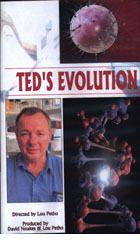
Ted’s Evolution 2002
Distributed by First Run/Icarus Films, 32 Court St., 21st Floor, Brooklyn, NY 11201; 800-876-1710
Produced by David Noakes and Lou Petho
Directed by Lou Petho
VHS, color, 55 min.
Sr. High - Adult
Anthropology, Biology, Genetics, Science
Date Entered: 03/17/2004
Reviewed by Christy Caldwell, Science Librarian, University of California, Santa CruzThis Australian film is aptly named, as it is more of a biography than a thorough examination of Darwinism or Lamarckism.
Ted’s Evolution is a biography of Ted Steele, a scientist who was convinced by his own lab work in 1975 that acquired traits could be passed to offspring. In other words, genetic changes to body cells could be transferred to reproductive cells. This transfer is thought not to be possible, otherwise known as the Weismann Barrier.
Mr. Steele believes that at least in the matter of immunity, this type of transfer is possible. In this case, this mechanism is more closely associated with the theorist Lamarck, who posited the well-known example that giraffes passed on long necks to their offspring after years of stretching their necks. Lamarck was debunked in favor of Darwin’s theory of Natural Selection. This film asserts that scientists refuse to look at Mr. Steele’s evidence to go against Darwin’s theory in favor of Lamarck’s. The narrator uses such phrases as, “If (Mr. Steele’s thesis is) true, this would shake evolutionary theory to its core.” It is framed as a scientist fighting against the “scientific establishment.”
But what the video actually shows is much more subdued. Scientists read Mr. Steele’s original paper. Efforts were made to replicate his findings (a keystone of sound science), and those efforts failed. Mr. Steele routinely insisted that each failure had a technical problem or a statistical gathering problem, but the scientists seemed to genuinely want to find the truth.
The story follows Mr. Steele over a 25-year career as he loses positions, moves labs, presents at conferences, argues with other scientists, and meets with scientists willing to examine his ideas. At one point, he is fired as a professor because of a grading controversy with his university. This seems to validate his feeling of ostracism due to his fringe scientific beliefs. The video ends with one or two labs that have promising results using gene tagging technology to track genes as they cross cells. But as science is ongoing the final results are not revealed.
This film may be novel to students who have a “static” view of science. The scientists are candid and passionate about their subjects, they insist upon rigorous process, they publish and present findings, they argue and disagree, and they complain constantly about the lack of research funding. But this interesting parallel storyline is not enough to recommend a film that is largely a biography of a man who is angry that his original research findings could not be replicated.
If Mr. Steele’s original thesis is correct, it will certainly be an important discovery, and be added to growing body of evidence we already have for evolution, but the consequence of such a discovery will not even begin to reach the hyperbole voiced in this film.
Awards
- Winner, 2003 BANFF Rockie Award, Popular Science and Natural History Category
- 2003 International Scientific Film Festival (Hungary)
- 2003 Scinema Film Festival (Australia)